Topic: Relationship Of Transported Particle Size To Water Velocity
Relationship Of Transported Particle Size To Water Velocity
A river’s current carries sediments into the ocean. Which sediment size will most likely be deposited in deeper water farthest from the shore?
(1) pebble
(2) sand
(3) silt
(4) clay
The minimum stream velocity necessary to transport a sediment particle that is 0.1 centimeter in diameter is closest to
(1) 0.1 cm/s
(2) 0.002 cm/s
(3) 5.5 cm/s
(4) 10.0 cm/s
What is the minimum water velocity necessary to maintain movement of 0.1-centimeter-diameter particles in a stream?
(1) 0.02 cm/s
(2) 0.5 cm/s
(3) 5.0 cm/s
(4) 20.0 cm/s


What is the largest type of sediment that could be transported at location B?
(1) silt
(2) sand
(3) pebbles
(4) cobbles
Which particles most likely will be deposited fi rst as the velocity of a stream carrying a mixture of particles decreases?
(1) small, fl at, low-density particles
(2) small, round, low-density particles
(3) large, fl at, high-density particles
(4) large, round, high-density particles
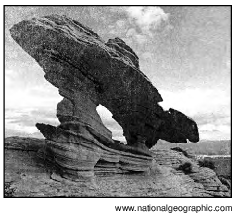
What is the range of grain sizes that are most commonly found in rock making up this feature?
(1) 0.0004 cm – 0.006 cm
(2) 0.006 cm – 0.2 cm
(3) 0.2 cm – 6.4 cm
(4) 6.4 cm – 25.6 cm

If the greatest velocity of the San Juan River on December 9 was 10 centimeters per second, what was the approximate diameter of the largest particles that the river could have carried?
(1) 1.0 cm
(2) 2.0 cm
(3) 10.0 cm
(4) 0.2 cm
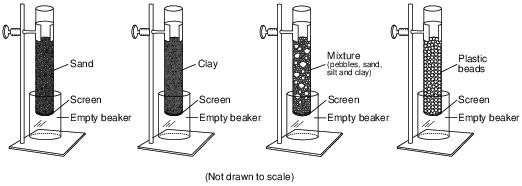

Based on the particle diameter of the plastic beads, identify the type of sediment represented by these beads. [1]
Allow 1 credit for pebbles.
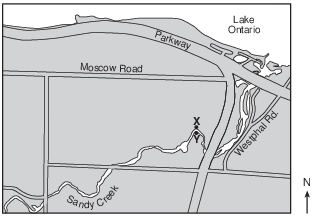
The symbols representing four sediment particles are shown in the key in the image below. These particles are being transported by Sandy Creek into Lake Ontario. On the cross section in the image provided, draw the symbols on the bottom of Lake Ontario to show the relative position where each sediment particle is most likely deposited. [1]
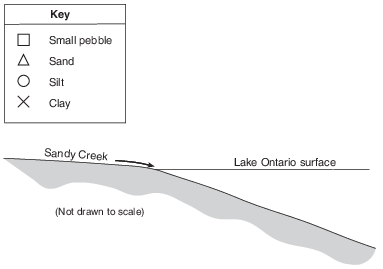
Allow 1 credit if the relative positions of the symbols or particle names are in the order shown.
• Example of a 1-credit response:
• 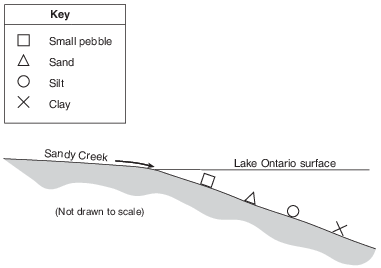

The stream velocity at location A is 100 centimeters per second, and the stream velocity at location B is10 centimeters per second. Identify one possible particle diameter that would most likely be deposited
between points A and B. [1]
cm
Allow 1 credit for any value from 0.18 cm to 2.5 cm.
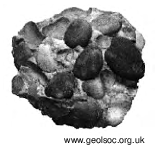
Identify the total possible range of particle diameters, in centimeters, for a particle to be classified as a pebble. [1]
The range is from _____________ cm to _____________ cm.
Allow 1 credit for 0.2 cm to 6.4 cm.

State one possible cause for the increase in stream discharge on March 15. [1]
Allow 1 credit. Acceptable responses include, but are not limited to:
• — precipitation
• — rain shower
• — snowmelt
• — increased runoff
• — flooding
• — increase in the volume of water in the stream
• Note: Do not allow credit for “velocity of water” or “increase in water velocity” because water
• velocity is a result of an increase in water volume or discharge.
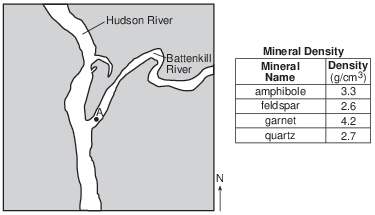
Identify the diameter of the largest particle that would be carried at point A when the velocity of the Battenkill River is 50 cm/s. [1]
cm
Allow 1 credit for any value from 0.8 cm to 1.1 cm.
Determine the velocity of the stream at location E where the largest particle being carried at location E has a diameter of 10.0 centimeters. [1]
cm/s
Allow 1 credit for any value from 150 cm/s to 250 cm/s.
The Dust Bowl
In the 1930s, several years of drought affected over 100 million acres in the Great Plains from North Dakota to Texas. For several decades before this drought, farmers had plowed the prairie and loosened the soil. When the soil became extremely dry from lack of rain, strong prairie winds easily removed huge amounts of soil from the farms, forming dust storms. This region was called the Dust Bowl.
In the spring of 1934, a windstorm lasting a day and a half created a dust cloud nearly 2000 kilometers long and caused “muddy rains” in New York State and “black snow” in Vermont. Months later, a Colorado storm carried dust approximately3 kilometers up into the atmosphere and transported it 3000 kilometers, creating
twilight conditions at midday in New York State.

Explain why the dust clouds that moved to the east coast of the United States during the 1934 storm were composed mostly of silt and clay particles instead of sand. [1]
Allow 1 credit. Acceptable responses include, but are not limited to:
• — The velocity of the wind could carry only small/less dense/flatter particles.
• — Sand is heavier and not likely to be carried that far.
• — The velocity of the wind was not great enough to carry sand particles.
• — Smaller particles are eroded more easily.
• — Silt and clay are smaller-sized particles.
